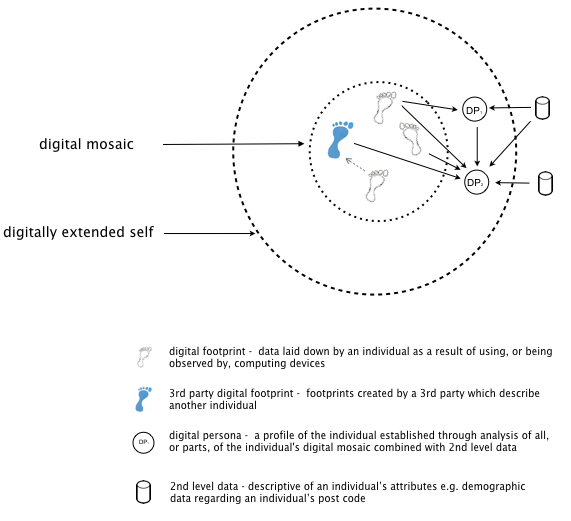User:SwintonBrian/sandbox
Digitally Extended Self[edit]
The digitally extended self is the extension of the self in the virtual world. Defined through a constructionist view of personal data following a lexicological analysis of the terms used to label types of personal data. [1] It consists of the following elements:
- Digital Footprint: data descriptive of an individual, laid down by that individual as a result of using, or being observed by, computing devices;
- Third-party Digital Footprint: digital footprints created by an individual, or a computer system, which are descriptive of another individual (the data subject);
- Digital Mosaic: a collection of digital footprints which can be used to create a picture of a person; a simple digital mosaic consists of a person’s own digital footprints, whereas a full digital mosaic is used to describe the collection of both an individual’s own and third-party digital footprints;
- Digital Persona: a model of an individual created by the analysis of digital footprints and/or other digital personas and optionally additional second-level data;
- Digitally Extended Self: the combination of the above elements to provide the fullest possible digital representation of an individual.

Digitally Extended Self, consisting of digital footprint, third party digital footprints, digital mosaic, digital personas, and third party data
The first image presents a model of the categories of personal data defined above. It illustrate the relationships between the categories of data, and also how as one moves out from the centre the individual has less knowledge and control of their own data.
The centric model represents the whole of the digitally extended self; however, data is transferred between organisations, and it is this that is possibly the major challenge for individuals wanting to track there own data. The model below illustrates the digitally extended self composed of multiple sets of data held by a number of organisations, between which, data may be exchanged.
In the centric model above the data categories remain intact and illustrate all of an individual’s data. Movement of data between organisational instances is not represented. The location of the data, whilst of interest to the individual, is an attribute of the data rather than of the individual. It answers the question, who knows about me and where are they, rather than what is known about me. This may be compared to the categorisation of books in libraries that allows for them to be grouped by topic but does not track to whom they may be loaned at any one time. The location of the book is an attribute of the book rather than its contents.

The location and movement information associated with an individual’s digitally extended self is important in order that its extent can be discovered, and to help when exploring its spread from organisation to organisation. Unlike a library where location is a matter of knowing where possessions are located, the digitally extended self has a more intimate relationship with people, with the ability to constrain or enhance a life, and as an extension of the mind as we outsource our thinking into the digital world.
The location of personal data may be, together with the details of algorithms used to create digital personas, the greatest challenges to transparency in its relationship to privacy legislation.
- ^ Parkinson; et al. "The Digitally Extended Self: A lexicological analysis of personal data". Journal of Information Science.
{{cite journal}}: Explicit use of et al. in:|last=(help)


